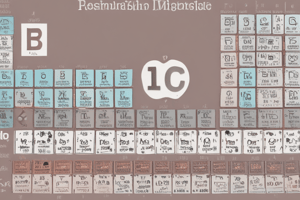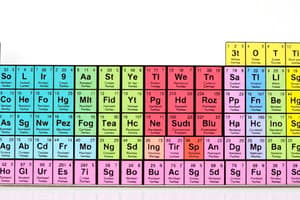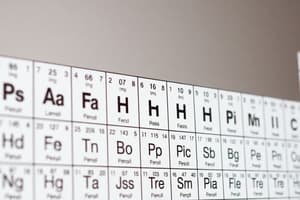Podcast
Questions and Answers
What does the term 'halogen' originate from?
What does the term 'halogen' originate from?
- French word for 'light'
- German word for 'gas'
- Greek word for 'salt' (correct)
- Latin word for 'fire'
Which statement accurately describes noble gases?
Which statement accurately describes noble gases?
- They are primarily found in liquid form.
- They are colorless gases with very low reactivity. (correct)
- They easily form compounds with other elements.
- They are highly reactive chemical elements.
Which of the following properties is NOT associated with metals?
Which of the following properties is NOT associated with metals?
- Good conductors of heat and electricity
- Ductile and malleable
- Dull appearance (correct)
- High melting points
What property characterizes nonmetals?
What property characterizes nonmetals?
What characteristic is true of semimetals?
What characteristic is true of semimetals?
Which of the following best defines pure substances?
Which of the following best defines pure substances?
Which is true about elements?
Which is true about elements?
What defines an element in chemistry?
What defines an element in chemistry?
What is an example of a pure substance?
What is an example of a pure substance?
Which groups make up the main groups of the periodic table?
Which groups make up the main groups of the periodic table?
What are alkali metals known for?
What are alkali metals known for?
Which of the following statements is true about alkaline earth metals?
Which of the following statements is true about alkaline earth metals?
Where are halogens commonly found in nature?
Where are halogens commonly found in nature?
How many groups of transition metals are present in the periodic table?
How many groups of transition metals are present in the periodic table?
What characteristic do all alkali metals share?
What characteristic do all alkali metals share?
What distinguishes inner transition metals from other elements?
What distinguishes inner transition metals from other elements?
What type of compound is formed when electrons are shared equally between atoms?
What type of compound is formed when electrons are shared equally between atoms?
What is the chemical formula for acetic acid?
What is the chemical formula for acetic acid?
What distinguishes ionic compounds from covalent compounds?
What distinguishes ionic compounds from covalent compounds?
What is a formula unit in relation to ionic compounds?
What is a formula unit in relation to ionic compounds?
Which of the following represents a polar covalent compound?
Which of the following represents a polar covalent compound?
What type of model is used to depict the three-dimensional shape of molecules?
What type of model is used to depict the three-dimensional shape of molecules?
Which of these is NOT a characteristic of molecular formulas?
Which of these is NOT a characteristic of molecular formulas?
What do structural formulas represent in a molecule?
What do structural formulas represent in a molecule?
What do ball-and-stick models represent in molecular structures?
What do ball-and-stick models represent in molecular structures?
Which of the following accurately represents the molecular formula for alanine?
Which of the following accurately represents the molecular formula for alanine?
What does the formula unit of sodium chloride indicate?
What does the formula unit of sodium chloride indicate?
In an ionic compound, what must the total positive and negative charges equal?
In an ionic compound, what must the total positive and negative charges equal?
Which compound is an example of a binary ionic compound?
Which compound is an example of a binary ionic compound?
What is the correct order for writing the formula of an ionic compound?
What is the correct order for writing the formula of an ionic compound?
Which of the following is true about the molecular formula for ethylene glycol?
Which of the following is true about the molecular formula for ethylene glycol?
What determines the ratio of ions in an ionic compound?
What determines the ratio of ions in an ionic compound?
What is the correct name for the compound with the formula Fe(NO3)3?
What is the correct name for the compound with the formula Fe(NO3)3?
What is the formula for ammonium sulfate?
What is the formula for ammonium sulfate?
Which acid corresponds to the nitrate ion (NO3-)?
Which acid corresponds to the nitrate ion (NO3-)?
What is the name of the compound Ca3(PO4)2?
What is the name of the compound Ca3(PO4)2?
How is hypochlorite ion represented in chemical formula form?
How is hypochlorite ion represented in chemical formula form?
Which anion corresponds to the formula for dihydrogen phosphate?
Which anion corresponds to the formula for dihydrogen phosphate?
Which of the following formulas represents calcium sulfate?
Which of the following formulas represents calcium sulfate?
What is the correct name for HBrO3?
What is the correct name for HBrO3?
What is the systematic name for the compound with the formula P4O7?
What is the systematic name for the compound with the formula P4O7?
Which of the following is the correct name for the ion NO2−?
Which of the following is the correct name for the ion NO2−?
Which prefix is used to indicate the presence of one atom of an element in a binary molecular compound?
Which prefix is used to indicate the presence of one atom of an element in a binary molecular compound?
What is the name of the ion SO42−?
What is the name of the ion SO42−?
Which of the following compounds is correctly named as potassium fluoride?
Which of the following compounds is correctly named as potassium fluoride?
What is the correct systematic name for the compound N2O4?
What is the correct systematic name for the compound N2O4?
Which prefix is used for the ion that contains the fewest oxygens in a series of polyatomic oxoanions?
Which prefix is used for the ion that contains the fewest oxygens in a series of polyatomic oxoanions?
Flashcards
Element
Element
A pure substance that cannot be broken down into simpler substances by chemical means.
Chemical Compound
Chemical Compound
A substance that contains two or more elements chemically combined in a fixed ratio.
Chemical Formula
Chemical Formula
A representation of the relative number of atoms of each element in a chemical compound.
Main Groups
Main Groups
Signup and view all the flashcards
Transition Metals
Transition Metals
Signup and view all the flashcards
Inner Transition Metals
Inner Transition Metals
Signup and view all the flashcards
Alkali Metals
Alkali Metals
Signup and view all the flashcards
Alkaline Earth Metals
Alkaline Earth Metals
Signup and view all the flashcards
Covalent Compounds
Covalent Compounds
Signup and view all the flashcards
Ionic Compounds
Ionic Compounds
Signup and view all the flashcards
Molecular Formula
Molecular Formula
Signup and view all the flashcards
Formula Unit
Formula Unit
Signup and view all the flashcards
Polar Covalent Bond
Polar Covalent Bond
Signup and view all the flashcards
Structural Formula
Structural Formula
Signup and view all the flashcards
Ball and Stick Model
Ball and Stick Model
Signup and view all the flashcards
Space-Filling Model
Space-Filling Model
Signup and view all the flashcards
Halogens
Halogens
Signup and view all the flashcards
Noble Gases
Noble Gases
Signup and view all the flashcards
Metals
Metals
Signup and view all the flashcards
Properties of Metals
Properties of Metals
Signup and view all the flashcards
Nonmetals
Nonmetals
Signup and view all the flashcards
Properties of Nonmetals
Properties of Nonmetals
Signup and view all the flashcards
Semimetals (Metalloids)
Semimetals (Metalloids)
Signup and view all the flashcards
Properties of Semimetals
Properties of Semimetals
Signup and view all the flashcards
Hydrogen Containing Polyatomic Ion
Hydrogen Containing Polyatomic Ion
Signup and view all the flashcards
Polyatomic Anion
Polyatomic Anion
Signup and view all the flashcards
Oxoacid
Oxoacid
Signup and view all the flashcards
Binary Acid
Binary Acid
Signup and view all the flashcards
Acid Naming
Acid Naming
Signup and view all the flashcards
Binary Compound
Binary Compound
Signup and view all the flashcards
Ionic Crystal
Ionic Crystal
Signup and view all the flashcards
Principle of Electrical neutrality
Principle of Electrical neutrality
Signup and view all the flashcards
Ionic Ratio
Ionic Ratio
Signup and view all the flashcards
Systematic Name
Systematic Name
Signup and view all the flashcards
Ion
Ion
Signup and view all the flashcards
Cation
Cation
Signup and view all the flashcards
Anion
Anion
Signup and view all the flashcards
Molecular Compound
Molecular Compound
Signup and view all the flashcards
Oxoanion
Oxoanion
Signup and view all the flashcards
Study Notes
Matter Classification
- Matter is anything that has mass and takes up space.
- Matter can be classified into mixtures and pure substances.
- Pure substances are further classified into elements and chemical compounds.
Pure Substances
- Elements are fundamental substances that cannot be broken down into simpler substances by chemical means.
- Elements consist of only one kind of atom (same atomic number).
- Elements can exist as atoms or molecules. (e.g., Ar, N₂)
- Chemical compounds are formed when two or more different elements combine chemically.
- Compounds consist of atoms of two or more different elements bound together in a fixed ratio.
Mixtures
- Mixtures are a blend of two or more substances in some arbitrary proportion.
- Mixtures can be separated by physical methods.
- Mixtures retain the properties of their component substances.
- Mixtures can be homogeneous or heterogeneous.
- Homogeneous mixtures have a uniform composition throughout the sample. Examples include solutions and alloys.
- Heterogeneous mixtures have a non-uniform composition throughout the sample with visible differences in composition. Examples include suspensions and colloids.
Separation of Mixtures
- Separation techniques are based on the different physical properties of the components in mixtures.
- Distillation separates mixtures based on the difference in boiling points of the components.
- Filtration separates mixtures based on the difference in particle size.
- Evaporation separates mixtures based on the difference in volatility.
- Chromatography separates mixtures based on the difference in adherence to a surface.
Elements and the Periodic Table
- Elements are arranged in the periodic table, which organizes them by increasing atomic number.
- The periodic table arranges elements into main groups (columns 1A-8A), transition metals (3B-2B) and inner transition metals (14 groups between 3B and 4B, including lanthanides and actinides).
Chemical Properties of Elements
- Alkali metals (Group 1A) react rapidly and sometimes violently with water and are never found as pure elements in nature.
- Alkaline earth metals (Group 2A) are lustrous silvery metals, less reactive than alkali metals.
- Halogens (Group 7A) are colorful, corrosive nonmetals, never found in nature as pure elements.
- Noble gases (Group 8A) are colorless, have very low chemical reactivity, and rarely combine with other elements.
- Metals are typically solids with high melting points and high densities and have a bright, metallic luster; they are good conductors of heat and electricity, and are ductile and malleable.
- Nonmetals typically have low melting points and low densities and have a dull appearance; they are poor conductors of heat and electricity, and are not malleable or ductile.
- Metalloids (semimetals) exhibit properties of both metals and nonmetals.
Atoms and Molecules
- On the microscopic level, matter consists of atoms and molecules.
- In a molecule, atoms are joined together by covalent bonds.
- Molecules can consist of the same or different types of atoms.
Compounds and Chemical Bonds
- Chemical bonds join atoms together to form compounds.
- Compounds can be classified based on the types of bonds they contain:
- Covalent bonds form when atoms share electrons.
- Ionic bonds form when there is a transfer of electrons between atoms.
lonic Compounds and Formula Units
- Ionic compounds consist of cations (positive ions) and anions (negative ions) held together by ionic bonds.
- The chemical formula of an ionic compound is called a formula unit, showing the simplest whole-number ratio of ions.
- Subscripts indicate the number of ions required to produce an electrically neutral compound. The sum of cation charges must equal the sum of anion charges.
- Main-group metals usually form cations whose charge is equal to the group number.
- Main-group nonmetals usually form anions whose charge is equal to the group number minus 8.
- Transition metals may form more than one cation with different positive charges.
- The name of the cation is followed by the name of the anion (ending changed to -ide), to name the ionic compound.
Naming Compounds
- Common names are arbitrary and not always consistent among disciplines or languages.
- Systematic names identify the chemical composition, devised by IUPAC.
- Binary ionic compounds are named by naming the cation first, followed by the anion.
- Cations formed from non-metals end in -ium.
- Binary molecular compounds are named by naming the first element and then naming the second element, including a prefix to indicate the quantities of each.
- Polyatomic ions are groups of atoms with a net electrical charge and are used as a complete unit.
- The prefixes "hypo" and "per" are used in the naming of polyatomic ions containing oxygen atoms.
- Acids are substances that release hydrogen ions (H+) in water when dissolved. Acids containing oxygen are named with the -ic or -ous suffix depending on oxygens present. Binary acids are named by replacing the -ide ending with -ic.
Studying That Suits You
Use AI to generate personalized quizzes and flashcards to suit your learning preferences.




